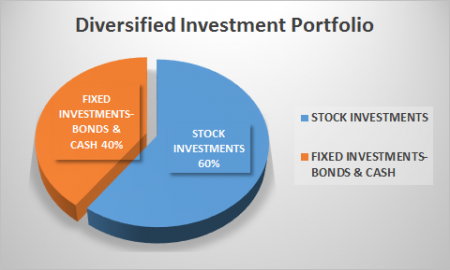What type of low risk investments should go in my bond allocation?
Justin from RootofGood ask;
I know I should have some bonds in my portfolio, but the rates are still near record lows. Should I invest in bonds, knowing there’s a decent chance I will lose money over the short to intermediate term?
Help, what is an investor to do? Low risk bonds are recommended by most investment professionals as a portion of a diversified portfolio. But these low risk investments are likely to deliver low or even negative returns in the near term.

This conservative investment portfolio looks great, as if it will nicely weather the storms of volatility because it is diversified between stock and fixed asset classes. (Assume that within the stock asset class there is geographic and market capitalization diversification.) In a diversified portfolio, the fixed asset class is supposed to deliver the “low risk investments”. But what happens when expectation is flawed?
The fixed-bond component is a bit tricky today. We are at a point in time when bond values have steadily increased for several years. There was even a period during the earlier parts of this century when bonds uncharacteristically outperformed stock returns.
Now, the outlook for bonds is pessimistic. This formerly, low risk investment class appears very risky.
Bond returns move in the opposite direction with interest rate movements. When interest rates increase, bond values decline. With market interest rates at a multi-year low, they will increase over the next several years. And that’s the problem for bond holders.
Who wants to knowingly hold an asset class that is destined to decline?
Bond Investing-What Should I Do?
In a recent email exchange with well Rick Ferri, Forbes columnist, author, and money manager, we were discussing bonds. I asked about his current thoughts on bond investing, given that if you hold all but the shortest term bond funds, when interest rise, the value of the bond fund will decline. Ferri echoed the wisdom that if you are investing for the long term (and he implied, reinvesting dividends), there’s no reason not to hold a diversified bond fund.
On the other hand, although I have some tolerance for risk, like Justin from Root of Good, I can’t stomach buying a bond fund when interest rates are low, knowing that it’s only a matter of time that the value of the fund will decline as interest rates rise.
Yet, Ferri’s underlying premise also makes sense. When interest rates rise, the coupon rates on the newer bonds will go up and greater coupon payments will be reinvested in cheaper shares of the bond fund. Over the long term, as the bond prices rise, the fund will compound and grow as well.
In this bond investing discussion, there are no easy answers.
What are bonds historical returns?
Historically, bond’s have returned about 5 percent per year. That’s not a bad return.
Right now, the low risk 10 year treasury bond is paying 2.658 percent. The bond price and yield are bouncing around a bit, but it is still a very low yield, when compared with it’s historical return.
Low Risk Investments For the Bond Portion of Your Portfolio
Following are several low risk fixed asset class investments to consider in this unusual bond market environment.
1. I bonds are tied to the rate of inflation and will go up in value as inflation rises. These safe government investments are a logical choice for the fixed portion of one’s portfolio. I invest the maximum allowed by law each year in I bonds.
2. Floating rate notes are a new investment recently issued by the US Government. As their name suggests, their interest rate is tied to a a floating rate, the interest rate on the 13 week treasury bill. They can be purchased with as little as $100 and they have a 2 year maturity. If interest rates rise, so will your interest payment. (The reverse is true as well.)
3. Individual bonds can be also be bought. For the small investor, in order to be diversified with your bond portfolio you need about $25,000. Generally, $5,000 is the smallest denomination available for an individual bond. With $25,000, you can buy five bonds with varying maturities. Go with investment grade bonds to reduce the default risk. Even if the bond value declines, at maturity you receive the face value.
4. Step up notes are another type of low risk fixed investment which offers an increasing interest rate. This type of bond protects you from being stuck in a low yielding investment when interest rates go up.
5. Laddering certificates of deposit (CDs), or buying CDs with varying maturities will allow your cash to become available at regular intervals to take advantage of expected increases in yield. Check online for high yield CDs.
Justin, there is no panacea in the low risk bond investment asset class, but if you can squeeze out a bit more return on your cash, and minimize the loss of principal, there’s no need to wait around for higher interest rates before investing. Additionally, as investors recently noticed, stock values go down as well as up, thus it’s wise to diversify.
Related
Best Investment When Interest Rates Are High
What other low risk investments are you considering?
How are you investing the fixed portion of your portfolio?
